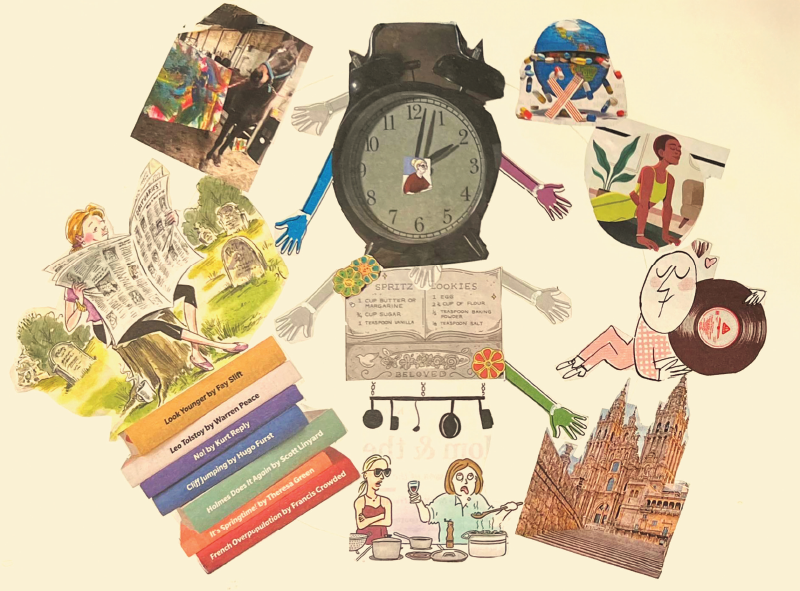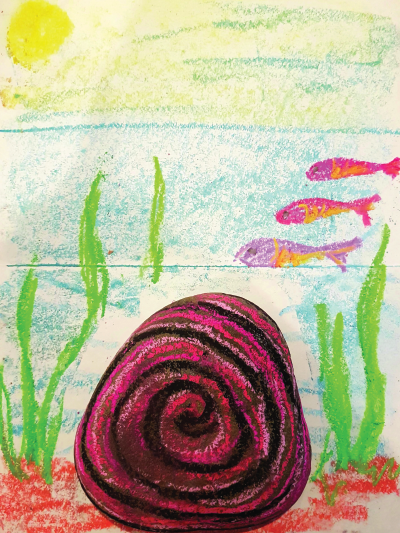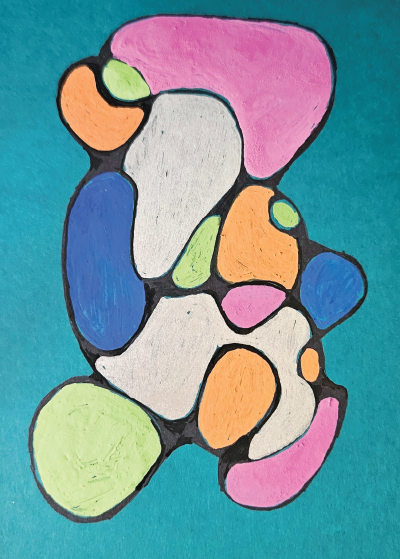An Art Therapist’s Perspective
VANESSA PATEL speaks with art therapist SANGEETA PRASAD about how creative expression becomes a language for what’s difficult to express—from children working through trauma to adults navigating pain, change, and the complexities of mental health—and why making art is a fundamental human need.
Q: What brought you to art therapy?
SP: I grew up in Chennai, India, where my mother ran a wonderful kindergarten school. The arts were always highly encouraged there, and I was always surrounded by children, education, and the arts. At college, in addition to my fine arts degree, I also completed one year of visual communication, and I realized I wanted to do something more—something that involved people and art.
To escape the humid heat of Chennai, I would frequently visit the beautiful, air-conditioned American Library [now the American Center]. And there I came across a book by Edith Kramer, a pioneer in art therapy who worked with children with special needs. I started reading it and I knew: this is what I wanted to learn more about.
I went on to study fine arts and then art therapy at George Washington University in 1985. My intention was to return to India and establish a special education school, as there was nothing like it at the time. I began by setting up a resource room at Bambino, my mother’s school, where we worked with children with autism, developmental delays, hyperactivity, and ADHD. At that time, these conditions were not well understood.
Q: How did you identify these children without the diagnostic tools we have today?
SP: It was more from observing behaviors—when a child didn’t want to come into school, or they were very anxious. My mother knew how to handle them. I implemented art therapy techniques I’d learned working with what they called at that time “emotionally disturbed children”—children with emotional issues, trauma, and some children on the spectrum. Having that background in abnormal psychology helped me understand how to work with them better.
We hired a teacher to work with the children using different methods from those in the regular classrooms, while also integrating them into the regular classrooms. I did art therapy and worked alongside the families.
After getting married, I returned to the U.S. to settle. The teacher who started with me at Bambino went on to establish a special education school in Chennai and continues to work with children with special needs.
Q: What’s the difference between a regular art class and an art therapy session?
SP: That’s an excellent question. In an art class, you’re very product-oriented and skill-oriented—you need to learn how to mix watercolors, perspective drawing, and your intention is really the product. In art therapy, the intention is the process. It’s okay for a child to scribble; in fact, we encourage that to help creative thinking.
Art can be used in many different ways—as a diagnostic tool, depending on what the person expresses, or for honing fine motor and gross motor skills. Our training helps us understand emotional expressions. Each one of us chooses different colors and different ways of expressing ourselves visually through art.
So, it’s really about understanding a person without them having to provide the words?
SP: It’s a combination. Sometimes, it could be only the artwork—a person might come in and take something, expressing themselves without having the words to say it. And sometimes it’s a combination of the two.
Q: For somebody who’s undergone trauma, how long does it typically take to connect with them using art therapy?
SP: It depends. I have clients who have come to me for more than five years. In hospitals, we have short-term and long-term clients; it’s different in schools—it really depends on the setting. We also work in oncology units, utilizing art to manage pain.
In art therapy,
the intention is the process.
When she drew it and saw it, we then talked in metaphor about what would help this fish. This allowed her to put the problem outside of herself and step back to see it. We discussed what causes these wounds and whether there was anything she could do to make the fish stronger.
Q: That’s really beautiful. You’re providing a safe space where there’s a lot of trust involved. Maybe that’s one reason clients keep coming back—it’s a place where they can really be themselves or discover who they really are.
SP: Right, absolutely. Sometimes they’ll stop coming, feel better, and then, after some time, if they need support again, they come back. That’s not a bad thing, because they need the support. They know what helps them. It’s a safe place for them to talk about these things.

Q: What techniques do you use?
SP: It depends on the person. With the client I just mentioned, I used visualization as a means of understanding her pain. With one client who is an adult but functioning like an eight-year-old, I focus on fine motor and gross motor skills. We’ve started a weaving project to improve left-hand-right-hand coordination. Sometimes I’ll do an art activity where she has to draw how she’s feeling about something that happened during the week, because she can be very impulsive and doesn’t know how to handle change.
We employ various techniques tailored to the client’s specific needs. Art is so versatile. We offer a diverse range of materials, including pencils, paints, clay, found objects, and natural elements. I utilize many of the materials we find and collect in nature in the art room. Recycled materials, things that people consider trash—we’re always collecting them.
She said, “Art fosters self-expression,
as the need to visually communicate
is deeply ingrained within us.”
Q: That’s incredible creativity. Can you talk about your books?
SP: I have two books out. One is Creative Expression: Say it with Art, written in India in 2008, mainly for teachers. I have now uploaded a PDF to my website and am making it freely accessible to teachers. The other is Using Art Therapy With Diverse Populations, where each chapter focuses on working with a different population, such as asylum seekers, prisoners, and various age groups. We have about twenty-seven authors contributing.
Our therapists can work in various settings, including community centers, hospitals, and schools, with all age groups, utilizing relevant techniques. That’s why training is essential. I have to emphasize that because a lot of people think that because they’re artists, they can do art therapy. But art therapy is a mental health profession. It requires a master’s level program—two to three years of very intense training with internships. There are also PhD programs where research is being conducted on how the arts have been utilized in indigenous populations. From prehistoric times, we see art being used on cave walls as a means of expression. The arts have always played a crucial role.

Q: So training typically involves art, education, and psychology?
SP: Yes, all three components. A lot of psychology and counseling techniques. In the U.S., it typically takes two to three years, depending on the program, and we usually recommend working with at least two populations under supervision. Currently, I teach at the Maharashtra Institute of Technology in Pune, India, where I helped design and launch a hybrid program. I still conduct supervision there, so our students work in various settings and we provide them with opportunities to discuss the challenges they face.

I utilize many of the materials we find
and collect in nature in the art room.
Recycled materials, things that people consider trash—
we’re always collecting them.
Q: You seem to have a very holistic approach to mental health. Would you say that’s something that’s becoming increasingly necessary?
SP: I think so. Medication is not the only solution. We need a multifaceted approach. When a person comes with an issue—trauma, developmental delays, life changes, a divorce—you want different tools for that person. Along with art therapy, I use a lot of mindfulness meditation. I’ve been trained as a mindful meditation teacher and have my own practice. I find the combination of mindfulness and art a wonderful mix.
Neuroscience is another passion of mine. If we understand the brain and the body, as well as the connections between them, that can really help us understand where our client is coming from and provide them with different tools to work with.
Q: I loved reading about the spiritual perspective in your work. I’m also a trainer in Heartfulness meditation, and sometimes after a meditation session, people want to sit and talk, and your role is to listen. You take it to the next level with your art therapy training.
SP: It’s really wonderful because in the schools I’m involved in, it’s become so apparent that children really need another means of expression. And art therapy provides one of those tools.

Q: You’ve also used this in prisons. How does that help with rehabilitation?
SP: There’s a wonderful art therapist named Dave Gussak who has done a lot of work and research into how art therapy can be used in settings where there can be a lot of aggression, where people come wounded, and where there are angry outbursts. There’s a lot of trauma, and then there’s re-traumatization happening within a prison.
One artwork that Dave shared in his book
is from an inmate who collected M&Ms,
and using M&Ms and water,
they did amazing paintings.
Art therapy can be used to help calm them down and improve their communication, leading to better understanding. Many people end up in prison because they have mental health issues. Helping them work through some of this can aid in rehabilitation. It needs specialized training and experience because it’s a unique place of work—you can’t use many art materials in that setting. No scissors, no glue. You have to be very vigilant.
Despite these restrictions, people have continued to create art. One artwork that Dave shared in his book is from an inmate who collected M&Ms, and using M&Ms and water, they did amazing paintings.

Q: So they used the dye from the M&Ms as paint. How ingenious!
SP: Yes, it says so much about the creativity of that person being in prison with limited resources. Art fosters self-expression, as the need to visually communicate is deeply ingrained within us.
Q: Like a primal need to connect with the outer world and express what you are.
SP: Right. And it also facilitates a connection to the inner world. Like meditation, there’s that inner and outer connection.
Q: That’s a lovely, hopeful note to end with. Thank you very much for your time.
Thanks for the opportunity.

For more information, visit sangeetaprasad.com

Sangeeta Prasad
Sangeeta Prasad, MA, ATR-BC, maintains a private art therapy practice in Virginia and serves as vice president of the Prasad Family Foundation. She served on the American Art Therapy Association Board of Direc... Read More

